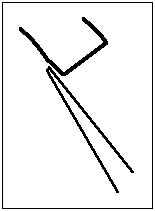1: Efficiency and Power Losses
A clock is usually taken to the shop for repair because the clock fails to keep
running. It runs for a while and stops because not enough power reaches the pendulum to
keep it running. One way to get it running is to double the weight, but this causes
enormous wear and consequent damage in the long run. The other way is to overhaul the
clock. The job of the repairman is to do whatever is necessary to minimize the power
losses between the weight and the pendulum. The clock is cleaned. Pivots are polished.
Worn bushings are replaced. Adjustments are made to the escapement to improve its
action. The clock is carefully lubricated. Other repairs are made as needed. These all
have the ultimate goal of reducing power losses.
There are two kinds of power losses in a clock: frictional losses and losses caused by
the action of the escapement (which result in additional frictional losses). Frictional
losses are easily understood. The lubricant has failed, causing drag. The bushings are
worn, so the gear and pinion teeth grind together. The pivots are scored, causing
frictional losses from rough surfaces. Dirt particles become imbedded in the worn
bushing, causing binding of the pivot, and so on.
Power losses caused by the action of the escapement are less obvious. The following
reasons are explained in detail in subsequent chapters. If the escape wheel rotates
clockwise, the force it exerts on the pallet would be in a different direction to that of the
pallet's movement. The greater the angle between the two directions, the greater the loss
of power as it is transferred from the escape wheel to the pallet. Consider that the pallets
rotate clockwise as the escape tooth pushes on the entry pallet, and counterclockwise as
the tooth pushes on the exit pallet, yet the escape wheel continues to rotate in the same
clockwise direction.
As the escape
tooth pushes on the pallet, the tooth exerts a force in the same direction as its direction of
travel at that point. If the point of contact on the pallet were at 90º to this direction, such
as on the locking face of the Graham pallet, the escape tooth would not move forwards
and no power would be transferred to the pallet.
 |
If the point of
contact were in the same direction as the escape tooth, so that the pallet's impulse face
were parallel to the path of the tooth, the tooth would pass by freely and provide no
impulse to the pallet.
 |
No power is transferred to the pallet when the angle is 90º or 0º. An angle in
between is needed: the angle that maximizes the power transfer. Find what direction the
escape tooth is moving in as it passes over the pallet, and the direction of the pallet. Then
determine the direction in which the pallet should receive power from the tooth. The
direction should be half way between those of the tooth and of the pallet. For maximum
efficiency, the pallet's impulse face needs to be at right angles (90º) to this
direction.
If the angle between the directions of the tooth and of the pallet were 90º, the
maximum achievable efficiency would be only 50%. This is achieved when the impulse
face's angle is at 45º to the direction of the tooth's travel. If the impulse face's angle were
25º, the efficiency would be merely 38%. That is a 24% power loss caused by improper
design. If the repairman could see this, he could adjust the impulse face's angle more
closely to what it should be, and maximize the pallet's efficiency, given the original
design he has to work with. Ideally, the impulse face's angle should be at 90º to the angle
half way between the directions of the tooth and of the pallet.
You may not find this easy to understand: power losses by escapement design are
less obvious. This will become clearer in the next chapters, as we draw the Graham
escapement. It should, however, have become clear to you how important the design of
the escapement is. I have seen clocks in which one pallet received a negligible impulse
from the escape wheel, so the maximum achievable efficiency was only 25%. Why
would they would not keep running?
Table of Contents
Escapements in Motion
Clock Repair Main Page
Links Page